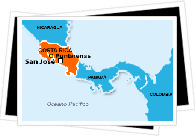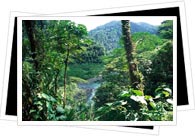
Many consider Costa Rica to be the 'green' country in Central America due to the number of beautiful parklands and reserves that are situated along its coastline, rainforests and volcanic craters.
In actual fact, Costa Rica is the most bio-diverse country in the world and can boast that 5-6% of the world's biodiversity can be located within its borders, including 10,000 plant species, 850 kinds of bird, over 200 types of mammal and over 1000 different species of salt and freshwater fish. A quarter of the Costa Rica's land is protected as parkland or nature reserves and there are currently 27 national parks, 58 wildlife refuges as well as other protected zones.
Situated between Nicaragua and Panama, the North Pacific Ocean and the Caribbean Sea, Costa Rica is just 51,100 square km in size. It is a tropical weather country with average temperatures ranging from 21-27 degrees Celsius with temperate breezes along the coast, peaking at temperatures in the mid thirties during the hottest days. The dry season (peak tourist season) runs from December to April, with the hottest weather between March and May, although the Caribbean coast and northern region do not have a distinct dry season. The wet season is from May to November and especially so in September and October. Average rainfall in Costa Rica is between 1.3 and 2.3 metres each year.

It is believed that at the time of Christopher Columbus' arrival, there were less than 20 native tribes in the area which now constitutes Costa Rica. The country was named the 'rich coast' as the conquerors saw the native Indian tribespeople wearing gold earrings and nose rings. They later discovered that Costa Rica was not rich in either gold or silver, and hampered by the extreme heat, jungle and disease, the country ended up being colonized far less than others in the area. The native population did not survive the battles and disease of the Spanish, so the early settlers of Costa Rica became landowners and worked their own lands.
In 1821, Costa Rica declared itself independent of Spain. During the subsequent 50 years, Costa Rica became a prime cultivator of coffee. Roads and ports were built and a judicial system was introduced. Slaves from Jamaica, convicts from America and forced servants from China were brought over to work on constructing the railway needed for transporting the coffee. San Jose, the capital city, was fast to develop and is credited with being one of the first three cities in the world to have electricity.
Nowadays, in addition to wildlife and nature tours, Costa Rica offers its visitors action and adventure in the form of water sports, scuba diving, horseriding, canyoning, or even flying through the treetops on one of the canopy tours. Other visitors can enjoy the nature soaking up the sun's rays on the sandy beaches, hiking the trails to see rare wildlife species or heading out in a boat for an afternoon of whale and dolphin watching. If none of that takes your fancy, you could choose to indulge in a day of luxury at a spa or health retreat, learn about chocolate or coffee on a special tour or haggle the 'Ticos' (Costa Ricans) for the best prices at the Costa Rica markets.